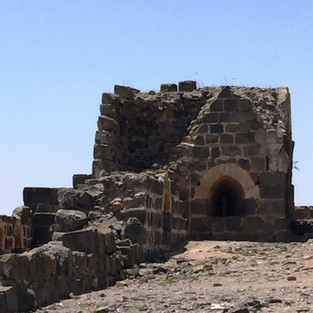GUARDIANS OF THE JORDAN VALLEY
- Levi Zelkind - Best Israel Tours

- Sep 2, 2020
- 3 min read
The Belvoir ("Great View" in French) Fortress, which is also called, in Hebrew, "Kochav Hayarden" ("Jordan' Star") is often nicknamed "one of the best-kept secrets in Israel." Sitting at the top of the steep hill, hidden from the view, this huge crusader castle dates back to the 12th century AD.
Designed to control the strategic path along the Jordan Valley, the fortress provided strong combat positioning and relative easiness to defend. And it also permitted a breathtaking view of the whole area (remember the name – Belvoir?).

Jordan Valley view from the fortress
The structure itself consists of two (outer and an inner) fortresses. In spite of the deliberate destruction and 800 years' age, It is still well-preserved, and visitors have a great opportunity to explore the grounds while taking in a stunning view over the Jordan Valley, the Sea of Galilee and up through the Golan Heights. It is the most complete Crusader fortress in Israel.
The first very modest fortress was built in the 11th century on the top of the hill, 500 m above the Jordan Valley. The Order of the Hospitallers purchased it in 1168 from the French Crusader's owner. The Hospitallers clearly realized the top strategic importance of the site and erected a huge fortress with impenetrable defenses.
From Belvoir, the garrison could closely watch the nearby bridge over the Jordan River, which served as the entryway from Transjordan into the Crusades Jerusalem Kingdom and watch the main road leading along the Jordan River, from Syria to Egypt.

Belvoir in the 12th century

Belvoir today
The fortress of Belvoir served its purpose as a major obstacle to the Muslims' goal of invading the Crusader Kingdom from the East and destroying it. It was attacked by Muslim forces in 1180, but its mighty fortifications relatively easily withstood the attacks. It was besieged by Saladin again in 1187, after the whole Crusades Army had been destroyed at the devastating battle of Karnei Hittin.
The whole of the Crusades Kingdom was lost, but Belvoir still managed to withhold the siege, until the defenders finally capitulated in 1189, a year and a half after the fall of Jerusalem.
The fortifications of Belvoir were further dismantled in 1217-1218 by the Muslim rulers who feared the recapture of the fortress by the new Crusades armies coming from Europe. But, in 1240, Belvoir was ceded to the Crusaders, by agreement. Lack of funds did not permit them to restore the fortifications, and it returned to Muslim control a few years later.
Belvoir powerful fortifications
The fortress consisted of an outer square citadel, which enclosed a smaller, inner square fortress. Its walls were built of large basalt rocks, held together by heavy iron joints. Well-protected cisterns for the storage of rainwater guaranteed sufficient water supply in times of a long siege. A huge, external tower surrounded by a low wall was built on the eastern side, facing the Jordan River.
The main entrance to the fortress was via an outer gateway. From here, one proceeded up a paved ramp to the top of the external tower, turned back and continued to the inner gate of the fortress. This complex structure ensured extreme difficulty for enemies to move ahead, even if they did manage to break into the Fortress.
This fortified gate was closed with a wooden door covered with metal and locked from the inside with a heavy wooden beam that fit into slots in the doorposts. A secondary entrance to the fortress was from the west, via a bridge suspended over the moat, which could be raised or destroyed when the fortress came under attack.
The Fortress
A man-made dry moat surrounded the fortress on three sides, while the steep slope and the external tower protected its eastern side. Huge towers rose at the four corners of the fortress, with additional towers between them at mid-point. The inner fortress could withstand a siege even after the main, outer fortress, had fallen into enemy hands.
The fortress of Belvoir remained in ruins until comprehensive excavations were conducted in the 1960s. The fortifications, still well-preserved under masses of rubble, were revealed and, upon completion of the restoration work, the site was finally opened to visitors. Today, Belvoir is the most complete and impressive Crusader fortress in Israel.
Wandering inside the fortress, climbing the walls and picking deep into the Jordan Valley, creates an inevitable feeling of being part of Belvoir defenders 800 years ago. The history simply stops here, at the citadel's gateway, and you need to take a deep breath to force yourself back to the 21st century.











Comments